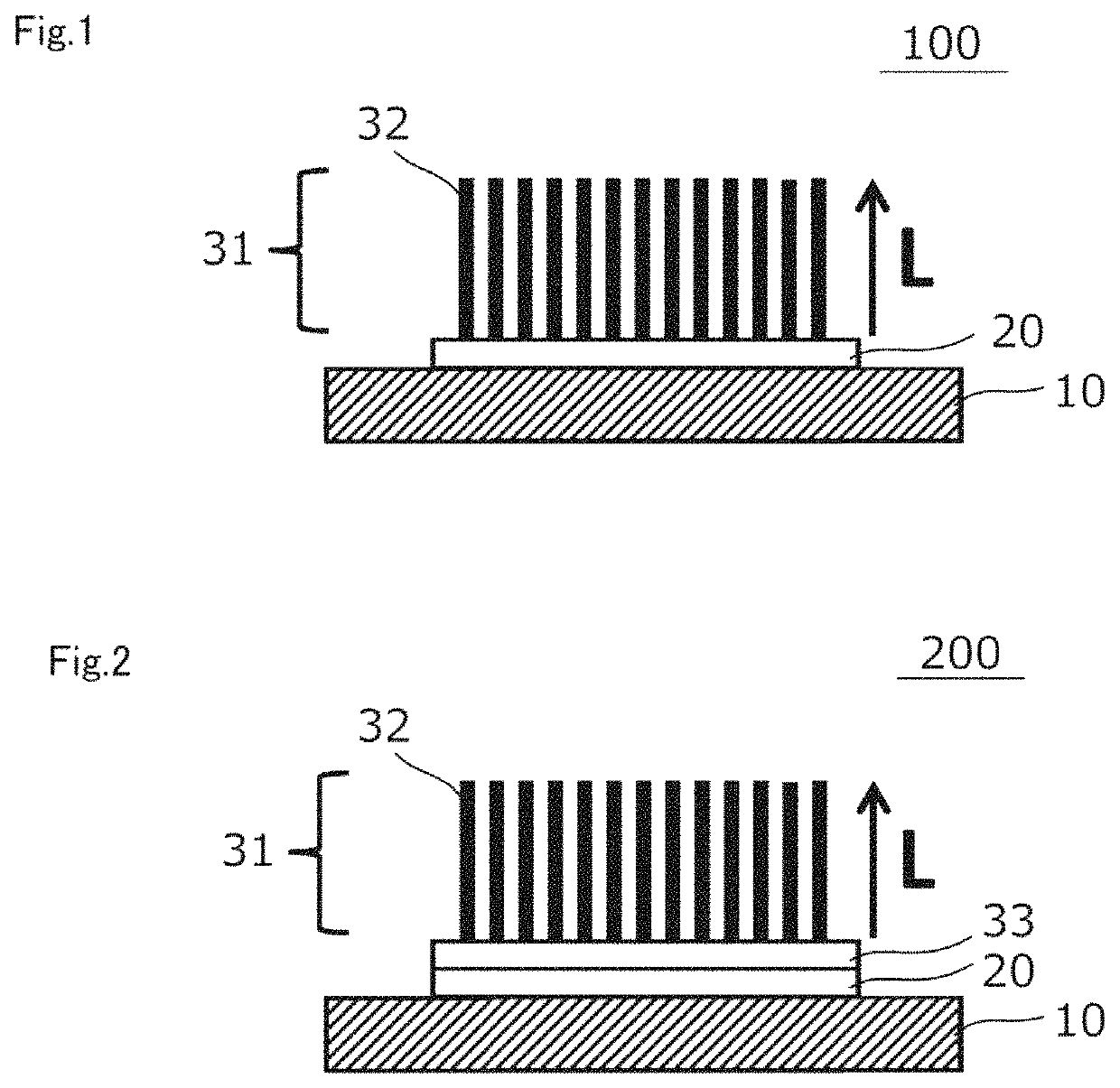Transport fixing jig
a technology for fixing jigs and jigs, which is applied in the field of transport fixing jigs, can solve the problems of low heat resistance, affecting the processing efficiency of objects, and affecting the quality of objects, so as to achieve excellent heat resistance, high gripping force, and hardly contaminating the effect of processing objects
- Summary
- Abstract
- Description
- Claims
- Application Information
AI Technical Summary
Benefits of technology
Problems solved by technology
Method used
Image
Examples
example 1
[0106]An adhesive (manufactured by ThreeBond Co., Ltd., product name: “TB3732,” binder: metal alkoxide, filler: alumina) was applied onto a first base material (made of ceramics; linear expansion coefficient: 8 ppm / ° C.) with a squeegee.
[0107]The carbon nanotube aggregate obtained in Production Example 1 was collected from the flat plate, and was arranged on the applied layer of the adhesive. At this time, the arrangement was performed so that the side of the carbon nanotube aggregate that had been in contact with the flat plate was brought into contact with the applied layer of the adhesive.
[0108]After that, a weight was placed on the side of the carbon nanotube aggregate opposite to the applied layer of the adhesive via a clean wafer, and a load of 50 g / cm2 was applied for 1 minute to bring the carbon nanotube aggregate and the applied layer of the adhesive into close contact with each other.
[0109]Next, a laminate obtained as described above was placed under normal temperature for...
example 2
[0111]A laminate was obtained in the same manner as in Example 1 except that an adhesive (manufactured by EM Japan Co., Ltd., product name: “G7716,” binder: silicate, filler: carbon) was used instead of the adhesive (manufactured by ThreeBond Co., Ltd., product name: “TB3732,” binder: metal alkoxide, filler: alumina). The laminate was placed under normal temperature for 2 hours and under an environment at 100° C. for 2 hours to cure the adhesive. Thus, a transport fixing jig including the first base material, the adhesive layer (thickness: 10 μm), and the carbon nanotube aggregate was obtained.
example 3
[0112]A laminate was obtained in the same manner as in Example 1 except that an adhesive (manufactured by AIN Co., Ltd., product name: “RG-57-2-3;” binder: organopolysiloxane, fillers: silicon dioxide (silica), titanium dioxide (titania), and potassium titanate, solvent: ethylene glycol dibutyl ether) was used instead of the adhesive (manufactured by ThreeBond Co., Ltd., product name: “TB3732,” binder: metal alkoxide, filler: alumina). The laminate was placed under an environment at 80° C. for 30 minutes, under an environment at 150° C. for 30 minutes, and under an environment at 400° C. for 2 hours to cure and calcine the adhesive. Thus, a transport fixing jig including the first base material, the adhesive layer (thickness: 20 μm), and the carbon nanotube aggregate was obtained.
PUM
| Property | Measurement | Unit |
|---|---|---|
| angle | aaaaa | aaaaa |
| angle | aaaaa | aaaaa |
| angle | aaaaa | aaaaa |
Abstract
Description
Claims
Application Information
 Login to View More
Login to View More - R&D
- Intellectual Property
- Life Sciences
- Materials
- Tech Scout
- Unparalleled Data Quality
- Higher Quality Content
- 60% Fewer Hallucinations
Browse by: Latest US Patents, China's latest patents, Technical Efficacy Thesaurus, Application Domain, Technology Topic, Popular Technical Reports.
© 2025 PatSnap. All rights reserved.Legal|Privacy policy|Modern Slavery Act Transparency Statement|Sitemap|About US| Contact US: help@patsnap.com


